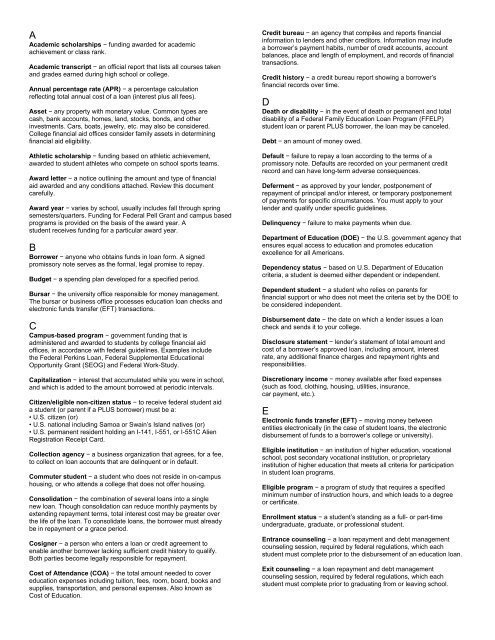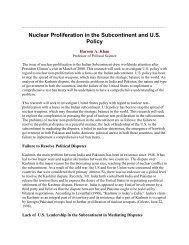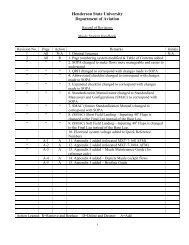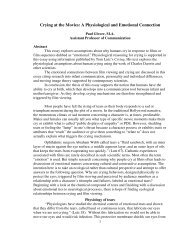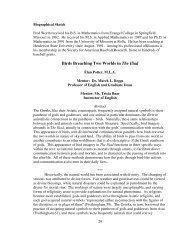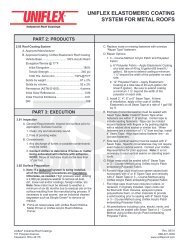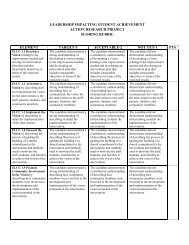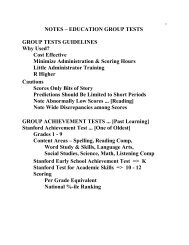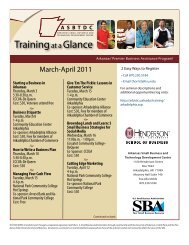Glossary of Financial Aid Terms - Henderson State University
Glossary of Financial Aid Terms - Henderson State University
Glossary of Financial Aid Terms - Henderson State University
You also want an ePaper? Increase the reach of your titles
YUMPU automatically turns print PDFs into web optimized ePapers that Google loves.
A<br />
Academic scholarships − funding awarded for academic<br />
achievement or class rank.<br />
Academic transcript − an <strong>of</strong>ficial report that lists all courses taken<br />
and grades earned during high school or college.<br />
Annual percentage rate (APR) − a percentage calculation<br />
reflecting total annual cost <strong>of</strong> a loan (interest plus all fees).<br />
Asset − any property with monetary value. Common types are<br />
cash, bank accounts, homes, land, stocks, bonds, and other<br />
investments. Cars, boats, jewelry, etc. may also be considered.<br />
College financial aid <strong>of</strong>fices consider family assets in determining<br />
financial aid eligibility.<br />
Athletic scholarship − funding based on athletic achievement,<br />
awarded to student athletes who compete on school sports teams.<br />
Award letter − a notice outlining the amount and type <strong>of</strong> financial<br />
aid awarded and any conditions attached. Review this document<br />
carefully.<br />
Award year − varies by school, usually includes fall through spring<br />
semesters/quarters. Funding for Federal Pell Grant and campus based<br />
programs is provided on the basis <strong>of</strong> the award year. A<br />
student receives funding for a particular award year.<br />
B<br />
Borrower − anyone who obtains funds in loan form. A signed<br />
promissory note serves as the formal, legal promise to repay.<br />
Budget − a spending plan developed for a specified period.<br />
Bursar − the university <strong>of</strong>fice responsible for money management.<br />
The bursar or business <strong>of</strong>fice processes education loan checks and<br />
electronic funds transfer (EFT) transactions.<br />
C<br />
Campus-based program − government funding that is<br />
administered and awarded to students by college financial aid<br />
<strong>of</strong>fices, in accordance with federal guidelines. Examples include<br />
the Federal Perkins Loan, Federal Supplemental Educational<br />
Opportunity Grant (SEOG) and Federal Work-Study.<br />
Capitalization − interest that accumulated while you were in school,<br />
and which is added to the amount borrowed at periodic intervals.<br />
Citizen/eligible non-citizen status − to receive federal student aid<br />
a student (or parent if a PLUS borrower) must be a:<br />
• U.S. citizen (or)<br />
• U.S. national including Samoa or Swain’s Island natives (or)<br />
• U.S. permanent resident holding an I-141, I-551, or I-551C Alien<br />
Registration Receipt Card.<br />
Collection agency − a business organization that agrees, for a fee,<br />
to collect on loan accounts that are delinquent or in default.<br />
Commuter student − a student who does not reside in on-campus<br />
housing, or who attends a college that does not <strong>of</strong>fer housing.<br />
Consolidation − the combination <strong>of</strong> several loans into a single<br />
new loan. Though consolidation can reduce monthly payments by<br />
extending repayment terms, total interest cost may be greater over<br />
the life <strong>of</strong> the loan. To consolidate loans, the borrower must already<br />
be in repayment or a grace period.<br />
Cosigner − a person who enters a loan or credit agreement to<br />
enable another borrower lacking sufficient credit history to qualify.<br />
Both parties become legally responsible for repayment.<br />
Cost <strong>of</strong> Attendance (COA) − the total amount needed to cover<br />
education expenses including tuition, fees, room, board, books and<br />
supplies, transportation, and personal expenses. Also known as<br />
Cost <strong>of</strong> Education.<br />
Credit bureau − an agency that compiles and reports financial<br />
information to lenders and other creditors. Information may include<br />
a borrower’s payment habits, number <strong>of</strong> credit accounts, account<br />
balances, place and length <strong>of</strong> employment, and records <strong>of</strong> financial<br />
transactions.<br />
Credit history − a credit bureau report showing a borrower’s<br />
financial records over time.<br />
D<br />
Death or disability − in the event <strong>of</strong> death or permanent and total<br />
disability <strong>of</strong> a Federal Family Education Loan Program (FFELP)<br />
student loan or parent PLUS borrower, the loan may be canceled.<br />
Debt − an amount <strong>of</strong> money owed.<br />
Default − failure to repay a loan according to the terms <strong>of</strong> a<br />
promissory note. Defaults are recorded on your permanent credit<br />
record and can have long-term adverse consequences.<br />
Deferment − as approved by your lender, postponement <strong>of</strong><br />
repayment <strong>of</strong> principal and/or interest, or temporary postponement<br />
<strong>of</strong> payments for specific circumstances. You must apply to your<br />
lender and qualify under specific guidelines.<br />
Delinquency − failure to make payments when due.<br />
Department <strong>of</strong> Education (DOE) − the U.S. government agency that<br />
ensures equal access to education and promotes education<br />
excellence for all Americans.<br />
Dependency status − based on U.S. Department <strong>of</strong> Education<br />
criteria, a student is deemed either dependent or independent.<br />
Dependent student − a student who relies on parents for<br />
financial support or who does not meet the criteria set by the DOE to<br />
be considered independent.<br />
Disbursement date − the date on which a lender issues a loan<br />
check and sends it to your college.<br />
Disclosure statement − lender’s statement <strong>of</strong> total amount and<br />
cost <strong>of</strong> a borrower’s approved loan, including amount, interest<br />
rate, any additional finance charges and repayment rights and<br />
responsibilities.<br />
Discretionary income − money available after fixed expenses<br />
(such as food, clothing, housing, utilities, insurance,<br />
car payment, etc.).<br />
E<br />
Electronic funds transfer (EFT) − moving money between<br />
entities electronically (in the case <strong>of</strong> student loans, the electronic<br />
disbursement <strong>of</strong> funds to a borrower’s college or university).<br />
Eligible institution − an institution <strong>of</strong> higher education, vocational<br />
school, post secondary vocational institution, or proprietary<br />
institution <strong>of</strong> higher education that meets all criteria for participation<br />
in student loan programs.<br />
Eligible program − a program <strong>of</strong> study that requires a specified<br />
minimum number <strong>of</strong> instruction hours, and which leads to a degree<br />
or certificate.<br />
Enrollment status − a student’s standing as a full- or part-time<br />
undergraduate, graduate, or pr<strong>of</strong>essional student.<br />
Entrance counseling − a loan repayment and debt management<br />
counseling session, required by federal regulations, which each<br />
student must complete prior to the disbursement <strong>of</strong> an education loan.<br />
Exit counseling − a loan repayment and debt management<br />
counseling session, required by federal regulations, which each<br />
student must complete prior to graduating from or leaving school.
Expected Family Contribution* (EFC) − based on federal criteria,<br />
the amount a family is expected to pay toward education.<br />
Expenses − incurred costs on which money is spent. Student<br />
expenses include tuition, room and board, and other living costs.<br />
F<br />
Federal consolidation loan − a federal program that permits<br />
multiple education loans taken by a student to be combined into a<br />
single new loan.<br />
Federal Direct Student Loan* (FDSL) − a program that allows<br />
students and parents to obtain education loans funded directly<br />
by the federal government, rather than by traditional lenders. Also<br />
known as the William D. Ford Federal Direct Loan Program.<br />
Federal Family Education Loan Program* − Federal Stafford,<br />
Federal Unsubsidized Stafford and Federal PLUS loan programs<br />
funded by private lenders and guaranteed by the federal<br />
government.<br />
Federal Pell Grants − the largest federal grant program. It awards<br />
funds to millions <strong>of</strong> lower-income students each year.<br />
Federal PLUS Loan* − a federal loan for parents <strong>of</strong> dependent<br />
undergraduates, which is not based on financial need. A parent<br />
can borrow as much as the cost <strong>of</strong> education minus financial aid.<br />
Repayment begins immediately.<br />
Federal Subsidized Stafford Loan* − a federal student loan<br />
program with eligibility requirements based on financial need. The<br />
federal government pays (subsidizes) interest incurred by student<br />
borrowers during in-school, authorized deferment, and grace<br />
periods. The college financial aid <strong>of</strong>fice determines loan amounts,<br />
subject to program limits. Repayment is deferred until six months<br />
after graduation.<br />
Federal Supplemental Educational Opportunity Grant* (FSEOG) −<br />
a need-based federal grant that can be used to supplement the<br />
Federal Pell Grant. Maximum award depends on college policy,<br />
availability <strong>of</strong> funds, total cost <strong>of</strong> education and amount <strong>of</strong> other<br />
financial aid awarded.<br />
Federal Unsubsidized Stafford Loan − a federal student loan<br />
program that is not based on need. Students are responsible for all<br />
loan interest, and may pay it during in-school, deferment and grace<br />
periods, or have it added to the loan balance. The financial aid <strong>of</strong>fice<br />
determines loan amounts, subject to program limits. Repayment is<br />
deferred until six months after graduation.<br />
Federal work-study program − part-time employment for students<br />
who need assistance to pay postsecondary education costs. A<br />
combination <strong>of</strong> federal and college or agency funds pays at least the<br />
federal minimum wage to eligible student employees.<br />
Fellowship − a grant for postgraduate study that may require<br />
teaching or research.<br />
Finance charge − a fee charged for the use <strong>of</strong> money over time,<br />
such as fees resulting from carrying an unpaid balance on a credit<br />
card.<br />
<strong>Financial</strong> aid − funding that is granted students to assist with<br />
educational expenses.<br />
<strong>Financial</strong> <strong>Aid</strong> Administrator (FAA) − an individual who prepares<br />
and communicates information, supervises functions, and<br />
provides advice regarding student loans, grants, scholarships,<br />
and employment programs. Responsibilities include interpreting,<br />
announcing, and implementing federal, state, and institutional<br />
policies and regulations, and responding to student and employee<br />
needs.<br />
<strong>Financial</strong> aid package − the total amount <strong>of</strong> financial aid a student<br />
receives. To help meet need, federal and non-federal aid such as<br />
grants, loans, or work-study assistance are combined in a package.<br />
The school’s <strong>Financial</strong> <strong>Aid</strong> Administrator uses available resources to<br />
give each student the best-possible aid package.<br />
<strong>Financial</strong> aid transcript − an <strong>of</strong>ficial report listing all financial aid<br />
and loans received during your college enrollment.<br />
<strong>Financial</strong> need − the cost <strong>of</strong> attendance (COA) minus expected<br />
family contribution (EFC), as determined by federal criteria.<br />
Fixed interest rate − an interest rate that is not subject to change.<br />
Free Application for Federal Student <strong>Aid</strong> (FAFSA) − the form<br />
used to determine financial aid eligibility for federal programs.<br />
Forbearance − a period <strong>of</strong> time during which a lender agrees to<br />
permit a borrower to temporarily postpone monthly payments,<br />
or temporarily reduce the monthly payment amount, based on<br />
hardship.<br />
G<br />
Garnishment <strong>of</strong> wages − the deduction <strong>of</strong> a portion <strong>of</strong> a borrower’s<br />
pay, with or without the borrower’s consent. A lender or the<br />
government may take this action to force repayment <strong>of</strong> a<br />
defaulted loan.<br />
Gift aid − financial aid not requiring repayment (e.g., scholarships<br />
and grants).<br />
Grace period − the period <strong>of</strong> time granted by a lender before the<br />
borrower is required to begin debt repayment. Interest may continue<br />
to accrue during this period.<br />
Graduate school − higher education beyond the baccalaureate level.<br />
Graduated repayment − a plan that <strong>of</strong>fers lower monthly payments<br />
at the beginning <strong>of</strong> the repayment term, with gradual increases in<br />
the monthly payment amount over time.<br />
Grant − a form <strong>of</strong> gift aid requiring no repayment.<br />
Guarantee fee − a percentage <strong>of</strong> the loan principal that is charged<br />
to a borrower as an insurance premium and deducted from loan<br />
proceeds.<br />
Guaranty agency − a government agency or non-pr<strong>of</strong>it institution<br />
that manages student loan insurance programs to protect lenders<br />
against losses resulting from borrower default, death, disability or<br />
bankruptcy.<br />
H<br />
Hardship − a period <strong>of</strong> financial difficulty during which the lender<br />
allows the borrower to delay repayment or decrease monthly<br />
payments.<br />
Holder − the institution that owns your loan.<br />
I<br />
Income-sensitive repayment − a loan repayment option with<br />
payments set at a percentage <strong>of</strong> your income and reviewed<br />
annually. To qualify, you must provide your lender with income<br />
documentation, including tax returns, each year.<br />
Independent student − for financial aid purposes, students<br />
meeting the federal definition must be: 24 years old or older, or<br />
married, or a veteran, or an orphan or a ward <strong>of</strong> the court, or<br />
have a legal dependent other than a spouse or be a graduate<br />
or pr<strong>of</strong>essional student.<br />
Installment loan − a loan that requires scheduled payments over a<br />
specified period. Examples include education loans, auto loans, and<br />
personal loans.<br />
Institutional grant − a form <strong>of</strong> gift aid funded by the college or<br />
university.
Insurance premium − also known as guarantee fee, a fee charged<br />
to the borrower by guarantor that is calculated as a percentage <strong>of</strong><br />
principal.<br />
Interest − the cost paid over time to use a lender’s money.<br />
Internship − work experience, paid or unpaid, acquired while in<br />
college.<br />
L<br />
Lender − a bank, savings and loan, credit union, or other financial<br />
institution that provides money through loans.<br />
Lender code − a number assigned to a lender by the U.S.<br />
Department <strong>of</strong> Education to designate a lender’s participation in the<br />
Federal Education Loan Programs.<br />
Liabilities − money owed to others.<br />
Loan application − the form prospective borrowers must complete<br />
to initiate a loan request.<br />
Loan fee − an amount that is calculated as a percentage <strong>of</strong><br />
principal and deducted from loan proceeds.<br />
Loan forgiveness – loan is forgiven due to death, disability, or other<br />
approved causes.<br />
Loan period − the academic year, or portion there<strong>of</strong>, in which an<br />
applicant is enrolled and seeking education loans.<br />
M<br />
Maker − the borrower.<br />
Master promissory note (MPN) − created to replace Federal<br />
Stafford Subsidized and Unsubsidized loan notes, the MPN<br />
simplifies the yearly borrowing process for students by allowing<br />
them to take advantage <strong>of</strong> a multi-use feature. Depending on the<br />
type <strong>of</strong> institution attended (either 2-year or 4-year); a student may<br />
be able to re-use a note to request additional funds on either a<br />
yearly or multi-year basis.<br />
Merit-based assistance − financial aid based on a student’s<br />
academic or creative achievements and abilities.<br />
Military scholarship − Reserve Officer Training Corps (ROTC)<br />
scholarships are available for the Air Force, Army, and Navy at many<br />
colleges and universities throughout the United <strong>State</strong>s. In addition to<br />
covering tuition and fees, books and supplies, military scholarships<br />
include a subsistence allowance.<br />
N<br />
Need analysis − a method used to determine Expected Family<br />
Contribution (EFC) and financial aid eligibility.<br />
Notice <strong>of</strong> guarantee − a disclosure statement specifying the terms<br />
<strong>of</strong> a borrower’s approved Stafford or PLUS loan and provided<br />
before the initial loan disbursement. It lists the amount<br />
approved, interest rate, fees, and date the loan funds will be<br />
disbursed.<br />
O<br />
Origination fee − a processing fee calculated as a percentage <strong>of</strong><br />
principal and deducted from the loan upon each disbursement.<br />
P<br />
Principal − the total amount borrowed.<br />
Promissory note − a written promise to repay a loan, signed by the<br />
borrower and cosigner (if applicable). This legal document describes<br />
loan conditions and repayment terms. Federal Stafford Loans<br />
require the use <strong>of</strong> a Master Promissory Note.<br />
Proprietary school − a for-pr<strong>of</strong>it educational institution usually<br />
<strong>of</strong>fering training for specific occupations.<br />
R<br />
Repayment schedule − statement <strong>of</strong> repayment terms sent to the<br />
borrower before first payment is due.<br />
Repayment period − the period during which you make payments<br />
on the loan.<br />
Restricted scholarship − gift aid limited to applicants meeting<br />
specific, limited criteria.<br />
S<br />
Satisfactory academic progress − the level <strong>of</strong> academic progress<br />
required <strong>of</strong> a student by the Higher Education Act in order to receive<br />
federal aid, including Federal Stafford and PLUS loans. Each<br />
school must establish a standard for evaluating a student’s efforts.<br />
In making this evaluation, the school must establish a normal<br />
timeframe for completion <strong>of</strong> the course <strong>of</strong> study in which the student<br />
is enrolled, and a method, such as work projects completed, to<br />
measure the quality <strong>of</strong> the student’s performance.<br />
Scholarship − a form <strong>of</strong> gift aid based on academic, athletic,<br />
creative, or other achievement, and does not require repayment.<br />
Secondary market − a lender, agency, or institution that buys<br />
education loans from originating lenders. Funds gained enable<br />
lenders to make new loans.<br />
Self-help − a form <strong>of</strong> financial aid including employment and loans.<br />
Servicer − a company that handles billing, collections, deferments,<br />
and other administrative duties for the lender or holder. Many<br />
education loan accounts are assigned to servicers.<br />
<strong>State</strong> grant − state funding usually based on financial need and<br />
reserved for students attending college in their home states.<br />
Student aid report* (SAR) − based on information student provided<br />
on the FAFSA, the report verifying submitted data, reporting the<br />
Expected Family Contribution(EFC), and informing the student <strong>of</strong><br />
eligibility for the Federal Pell Grant, if applicable.<br />
T<br />
Term − the number <strong>of</strong> months or years provided to pay back a loan.<br />
<strong>Terms</strong> − loan conditions as specified in the promissory note,<br />
generally including items such as interest rate, applicable fees, and<br />
monthly payment amount.<br />
Tuition − cost to enroll in classes.<br />
Tuition reimbursement − a benefit provided to employees by<br />
employers that covers full or partial costs <strong>of</strong> college courses.<br />
V<br />
Variable interest rate − an interest rate that can change<br />
periodically, as specified in the promissory note.<br />
Verification – the process in which a financial aid <strong>of</strong>fice uses a<br />
students and parents financial documents to verify the information<br />
input on the FAFSA as required by the US DOE.


